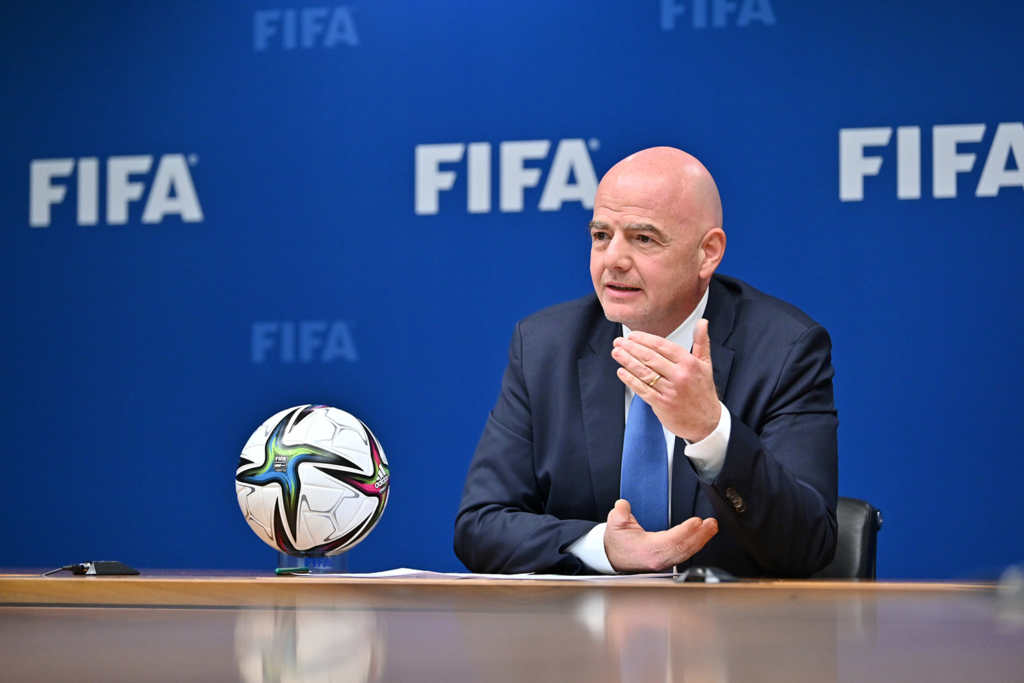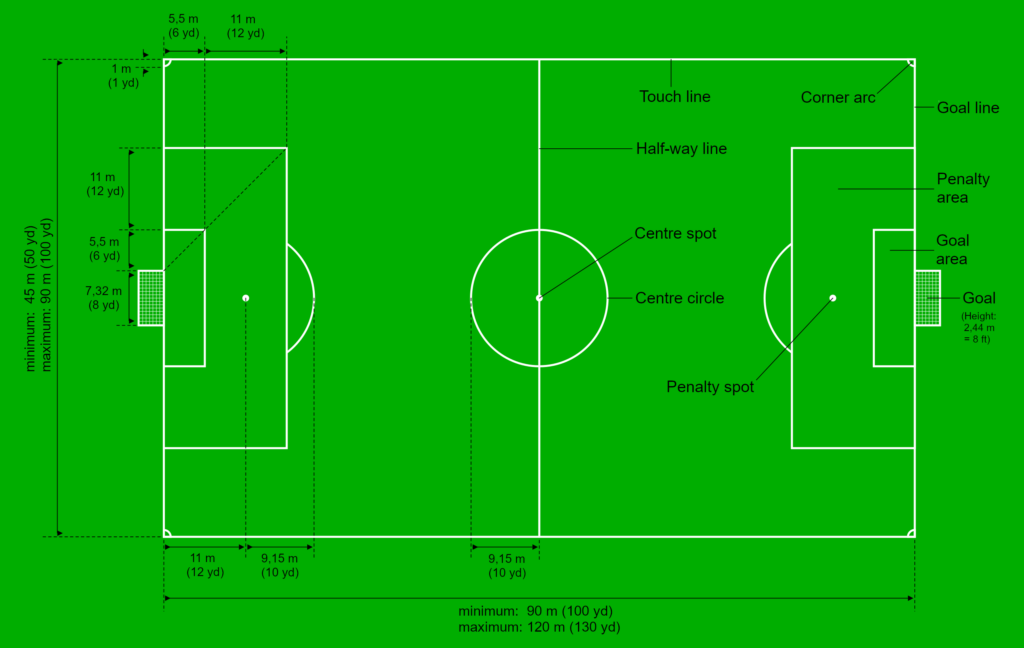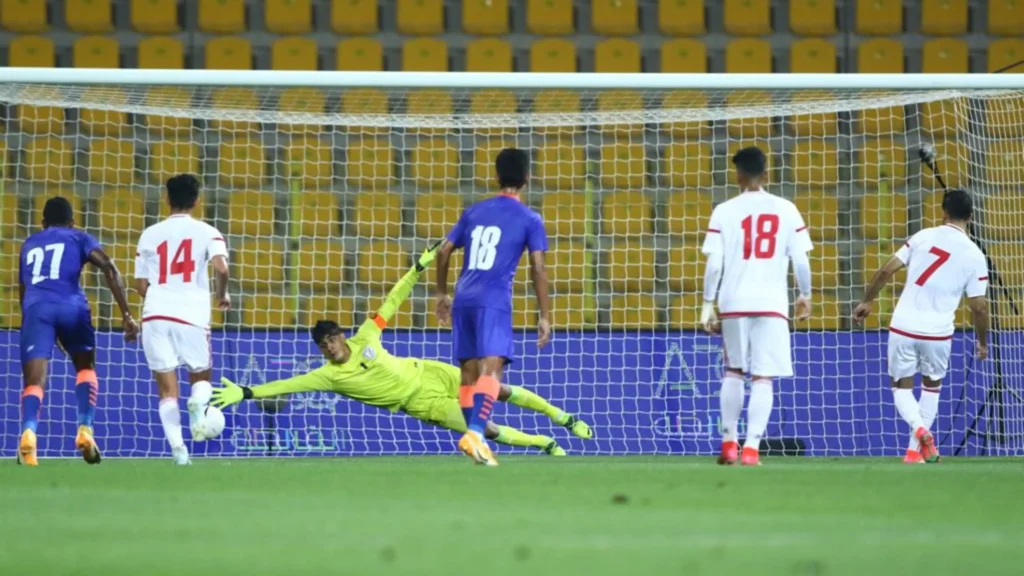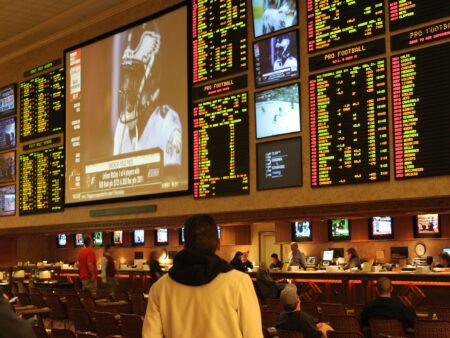In this article, we’ll be covering everything you need to know about football ground measurements.
Football Ground Measurements: Pitch Size, Goals, and Markings Explained
Welcome to our article on football ground measurements, where we’ll be discussing the importance of understanding the size of the pitch, the measurements of the goals, and the various line markings that make up a football field. Whether you’re a player, coach, official or football betting enthusiast, having a good understanding of these measurements is crucial to understanding the game of football.
Football has been played for centuries and has evolved over time, with various governing bodies like FIFA and the FA setting standards and regulations to ensure fair play. Understanding these regulations is vital, whether you’re playing in a local park or representing your country in an international match.
Table of Contents
- 1 Introduction to Football
- 2 Governing Bodies and Standards
- 3 FA Recommended Pitch Sizes
- 4 Additional Pitch Markings and Equipment
- 5 Football Goal Measurements
- 6 Field of Play and Line Markings
- 7 Artificial Turf Pitches
- 8 Different Age Groups and Pitch Sizes
- 9 Penalty Box and Penalty Arc
- 10 The Technical Area and Corner Kicks
- 11 Conclusion
- 12 FAQ
- 12.1 What are football ground measurements?
- 12.2 Why is it important to understand football ground measurements?
- 12.3 What are the recommended pitch sizes for different formats of football?
- 12.4 What are the additional pitch markings and equipment found on a football ground?
- 12.5 What are the measurements and specifications of football goals?
- 12.6 What are the various line markings on a football pitch?
- 12.7 What is the significance of artificial turf pitches in football?
- 12.8 How do pitch sizes vary for different age groups in football?
- 12.9 What are the penalty box and penalty arc in football?
- 12.10 What is the technical area in football, and what are the rules for corner kicks?
Introduction to Football
Football, also known as soccer, is a sport played by two teams of eleven players each, using a spherical ball. The objective of the game is to score by kicking the ball into the opponent’s goal. Football is the most popular sport in the world, with millions of fans worldwide.
The origins of football can be traced back to ancient civilizations, such as the Greeks, Romans, and Chinese, who played a game using a ball made of animal bladders or leather. The modern game of football was developed in England in the 19th century, where it quickly gained popularity and spread to other countries.
The basic rules of football are simple. Each team tries to score goals by moving the ball across the opponent’s goal line. The players are not allowed to touch the ball with their hands or arms, except for the goalkeeper, who can use their hands within the penalty area. The game is controlled by a referee, who enforces the laws of the game and decides on any rule violations.
Football is played at all levels, from amateur to professional. It is also played by people of all ages, from children to seniors. The game has its own language, with terms such as “offside“, “foul”, “header”, and “penalty” commonly used by players and fans.
Many countries have their own football leagues and competitions, such as the English Premier League, Spanish La Liga, and Italian Serie A. Football also has international competitions, such as the World Cup and the UEFA Champions League, which bring together the best teams from around the world.
Football is more than just a sport. It brings together people of different cultures, nationalities, and backgrounds. It teaches valuable skills such as teamwork, sportsmanship, and determination. It is a source of entertainment, excitement, and inspiration for millions of people around the world.

Governing Bodies and Standards
Football is one of the most popular sports in the world, with millions of fans and players taking to the field every day. With such a vast number of people involved, it is crucial to have governing bodies that set standards and regulations to ensure a level playing field and a fair game.
The two primary governing bodies for football are FIFA (Fédération Internationale de Football Association) and the FA (Football Association). FIFA is the international governing body for football and oversees the organization of international tournaments such as the World Cup. The FA, on the other hand, is the national governing body for football in England and regulates football at all levels of the game.
These governing bodies play a crucial role in setting and enforcing standards for football ground measurements. They ensure that the size of the playing surface, goals, and line markings are consistent across the game, providing a fair and safe environment for players of all ages and skill levels.
The standards and regulations set by these governing bodies are known as the laws of the game. These laws cover all aspects of football, from the dimensions of the pitch to the behavior of players and officials during a match.
FIFA publishes the laws of the game every year, and the FA has its own set of rules based on these laws. These governing bodies also have a hierarchical structure, with different committees responsible for different aspects of the game.
For example, the International Football Association Board (IFAB) is responsible for making changes to the laws of the game, while the FA has various committees to oversee player development, coach education, and referee training.
FA Recommended Pitch Sizes
The Football Association (FA) recommends different pitch sizes for various formats of football, based on the number of players and their age group. The recommended pitch sizes are as follows:
| Format of Football | Pitch Size (Length x Width) |
|---|---|
| 5-a-side | 30m x 20m |
| 7-a-side | 60m x 40m |
| 9-a-side | 80m x 50m |
| 11-a-side (Under 11s and Under 12s) | 90m x 60m |
| 11-a-side (Under 13s and above) | 100m x 64m |
It is important to note that pitch sizes may also vary based on the regulations of specific leagues or competitions. Therefore, it is always advisable to check with the relevant authorities before setting up a match.
Additionally, age groups may vary between different football associations or governing bodies. For example, the United States Youth Soccer Association (USYSA) recommends smaller pitch sizes for younger age groups, with a pitch size of 25m x 15m for 6 and under and 30m x 20m for 8 and under.
It is crucial to provide appropriate pitch sizes for different age groups to ensure fair play and development, allowing players to hone their skills and enjoy the game.
Additional Pitch Markings and Equipment
Football pitches have various additional markings and equipment that serve specific purposes during a match. Let’s take a closer look at these:
| Marking/Equipment | Description |
|---|---|
| Goal Line | The goal line marks the boundary between the field of play and the area behind the goal where the goalkeeper can handle the ball. |
| Penalty Area | The penalty area or box is a rectangular area in front of each goal that measures 16.5 m in length and 40.3 m in width. |
| Penalty Mark | The penalty mark is located 11 m from the goal line and is used to indicate the spot where penalty kicks are taken. |
| Halfway Line | The halfway line divides the pitch into two equal halves and is located midway between the two touchlines. |
| Goal Posts | The goal posts are two vertical posts that measure 2.44 m in height and are placed at the center of each goal line. |
| Corner Kick | The corner kick is awarded when the ball goes out of bounds over the goal line, but not into the goal, after being touched last by a defending player. The corner kick arc is drawn at a radius of 1 m from the corner flag to indicate the area where the ball must be placed during the kick. |
| Corner Flags | The corner flags are used to mark the four corners of the pitch, and are placed at the intersection of the touchline and goal line. |
| Center Circle | The center circle has a radius of 9.15 m and is drawn at the center of the pitch. It is used to indicate the area where the ball is placed during the kickoff at the beginning of each half, and after a goal is scored. |
| Technical Area | The technical area is a designated area on the sideline where the coach and other team officials can stand during the match. |
| Boundary Lines | The boundary lines mark the perimeter of the pitch and are used to indicate when the ball has gone out of bounds. |
Each of these markings and equipment serve an essential purpose in the game, and it is crucial for players, coaches, and officials to understand their significance.

Football Goal Measurements
Football goal measurements are an important aspect of the sport, as they determine the dimensions and specifications of the goalposts, horizontal crossbar, and goal lines. These measurements are set by the governing bodies of football to ensure fairness and consistency across all matches.
The maximum dimensions for a football goal are established by FIFA, with the goal posts standing at a height of 8 feet (2.44 meters) and the horizontal crossbar at a height of 8 yards (7.32 meters). The distance between the goal posts must be 24 feet (7.32 meters), and the goal line must extend the entire width of the pitch, which is typically 100-130 yards (90-120 meters) long and 50-100 yards (45-90 meters) wide.
The specifications for international matches may vary slightly, with the goal posts allowed to be up to 8.2 feet (2.5 meters) tall and 8.8 yards (8 meters) wide.
| Aspect | Measurements |
|---|---|
| Goal posts | 8 feet (2.44 meters) tall, 24 feet (7.32 meters) apart |
| Horizontal crossbar | 8 yards (7.32 meters) off the ground |
| Goal line | Extends the entire width of the pitch |
| International matches | Up to 8.2 feet (2.5 meters) tall, up to 8.8 yards (8 meters) wide |
It is important for players, coaches, and officials to understand these measurements to ensure fair play and accurate decision-making during matches.
Field of Play and Line Markings
A football pitch has specific measurements and line markings that define the playing area. The field of play must be rectangular and consist of a flat, natural or artificial grass surface. The pitch’s length is greater than its width, with the touchlines being longer than the goal lines.
The pitch is divided into two halves by the halfway line, which runs parallel to the touchlines. A center circle with a radius of 9.15 meters is marked at the center of the pitch, and a small circle with a radius of 0.5 meters is centered on the halfway line. Together, these markings indicate where players must be positioned at kickoff.
The penalty areas are marked on both ends of the pitch and are rectangles measuring 16.5 meters from the goal line and 40.3 meters wide. A penalty mark is located 11 meters from the goal line at the center of the penalty area, and the penalty arc with a radius of 9.15 meters is marked outside the penalty area.
The goal area is a smaller box marked within the penalty area and measures 5.5 meters from the goal line and 18.3 meters wide. The goal posts are located on the goal line at each end of the pitch, with a horizontal crossbar 2.44 meters above the ground.
The corner arcs are marked at each corner of the pitch, with the radius being one meter from the corner flag. The technical area is a marked area on the sideline for coaches and team officials to stand during the match.
| Field of Play and Line Markings | Measurements (in meters) |
|---|---|
| Length of pitch (touchline) | 100-110 |
| Width of pitch (goal line) | 64-75 |
| Center circle | 9.15 (radius) |
| Penalty area | 16.5 (depth) x 40.3 (width) |
| Penalty mark | 11 (distance from goal line) |
| Penalty arc | 9.15 (radius) |
| Goal area | 5.5 (depth) x 18.3 (width) |
| Goal posts | 2.44 (height) |
A well-maintained playing surface is essential for player safety and fair play. Regular maintenance, including mowing, fertilizing, and watering, can help keep the pitch in top condition.
According to FIFA regulations, the field of play is a rectangular area between 100-110 meters in length and 64-75 meters in width for international matches. However, the length and width can vary for non-international matches, as long as they fall within the specified range.

Artificial Turf Pitches
Artificial turf pitches, also known as synthetic turf or simply “astro turf,” have become increasingly popular in football due to their durability, low maintenance requirements, and adaptability to different weather conditions.
Unlike natural grass pitches, which can become muddy and slippery in wet weather, artificial pitches offer a consistent playing surface all year round, making them ideal for training and competitive matches. They also reduce the risk of injuries, particularly to the knees and ankles, as they provide a firmer, more stable base.
Another advantage of artificial turf pitches is their versatility. They can be used for a range of formats, from small-sided games to full-size matches, and can accommodate different age groups and skill levels.
However, it is important to note that there are some drawbacks to using artificial turf. One of the main concerns is the potential for increased player fatigue, as the harder surface can put more strain on the body. There are also concerns about the environmental impact of artificial turf, as it is made from synthetic materials and does not have the same ecological benefits as natural grass.
Despite these concerns, artificial turf pitches remain a popular choice for many football clubs and players. They offer a practical and cost-effective solution for providing a high-quality playing surface, and their adaptability makes them a valuable asset for communities and schools.
Different Age Groups and Pitch Sizes
Football ground dimensions vary according to the age group of players, with different field sizes recommended for different levels of play. Providing appropriate playing surfaces for young players is essential for their development and enjoyment of the game.
The following table outlines the recommended pitch sizes for various age groups:
| Age Group | Pitch Size (yards) |
|---|---|
| Under 6 | 20×30 |
| Under 7-8 | 30×40 |
| Under 9-10 | 40×60 |
| Under 11-12 | 50×80 |
| Under 13-14 | 60×100 |
| Under 15-16 | 70×110 |
| Under 17-18 | 80×120 |
| Adult (11-a-side) | 100×130 |
These recommended pitch sizes are meant to promote a fair and enjoyable playing experience for young players, with appropriate dimensions for their skill level and physical development. It’s important for coaches and officials to ensure that the playing surface is suitable for the age group and competitive level of the players.
Football fields for different age groups can also have variations in markings and equipment. For example, smaller goals may be used for younger age groups, and the penalty box may be smaller or non-existent. It is important to check the rules and regulations of the governing body for specific age group requirements.

Penalty Box and Penalty Arc
The penalty box, also known as the penalty area, is a rectangular box located at each end of the pitch. Its dimensions are 44 yards long and 18 yards wide. When a defending player commits a foul inside this area, the opposing team is awarded a penalty kick.
The penalty arc is a curved line outside the penalty box with a radius of 10 yards from the penalty spot. This area is where the defending team’s players must remain during a penalty kick. If any player from the defending team enters this area before the kick is taken, the penalty is retaken.
Penalty kicks are a crucial part of football and can often decide the outcome of a game. Therefore, it is essential to understand the dimensions and rules surrounding the penalty box and arc to avoid costly mistakes during a match.
The Technical Area and Corner Kicks
The technical area is a designated area on the sideline of a football pitch where coaches and team officials can stand during a match. It is usually situated in front of the team benches and is limited to a specific number of people. The technical area is intended to allow coaches to communicate with their players during the game and make substitutions.
Coaches are required to stay within the technical area and may be penalized if they enter the field of play or behave in an unsporting manner. The fourth official is responsible for monitoring the technical area and ensuring that regulations are followed.
Corner kicks are awarded to a team when the ball goes out of play over the end line, having been last touched by a player from the opposing team. The corner kick is taken from the corner of the pitch nearest to where the ball went out of play. The kicker must place the ball inside the corner arc before taking the kick.
Defending players must be at least ten yards away from the ball when the corner is taken. The attacking team can use this opportunity to create scoring opportunities by aiming for the goal or delivering the ball to a teammate in a good position to shoot.
Conclusion
Understanding football ground measurements is essential for players, coaches, and officials alike. By knowing the recommended pitch sizes, additional markings, and equipment specifications, everyone involved can ensure a fair and enjoyable game.
As we have seen, governing bodies like FIFA and the FA play a crucial role in setting standards and regulations for football ground dimensions. These regulations are put in place to maintain a safe and level playing field for all age groups and formats of the game.
It is also important to note that the rules and regulations surrounding football ground measurements are constantly evolving, and it is essential to stay informed of any updates or changes.
Whether playing on natural or artificial turf, coaches and players must consider the age group and pitch size to ensure a level playing field. These considerations contribute to the fairness of the game and promote skill development for young players. Ultimately, by understanding the various football ground measurements and their importance, we can all contribute to a safer, fairer, and more enjoyable football experience and make footbal bets more consciously.
FAQ
What are football ground measurements?
Football ground measurements refer to the various dimensions and markings found on a football pitch, including pitch size, goal measurements, and line markings.
Why is it important to understand football ground measurements?
Understanding football ground measurements is crucial for players, coaches, and officials as it ensures fair play, compliance with regulations, and a safe playing environment.
What are the recommended pitch sizes for different formats of football?
The recommended pitch sizes vary depending on the format of the game. For 5-a-side, 7-a-side, 9-a-side, and 11-a-side football, specific pitch size guidelines are provided by governing bodies like the FA.
What are the additional pitch markings and equipment found on a football ground?
Additional pitch markings include the goal line, penalty area, penalty mark, halfway line, corner kick markings, center circle, and boundary lines. Equipment includes the goal posts, corner flags, and technical area.
What are the measurements and specifications of football goals?
Football goals generally consist of goal posts, a horizontal crossbar, and goal lines. The height and width of the goal posts, the height of the crossbar, and the dimensions of the goal lines must adhere to specific regulations.
What are the various line markings on a football pitch?
The line markings on a football pitch include the touchlines, goal lines, halfway line, penalty areas, penalty mark, center circle, and corner arcs.
What is the significance of artificial turf pitches in football?
Artificial turf pitches have gained popularity in football due to their durability, all-weather usability, and consistent playing surface. They provide an alternative to natural grass pitches.
How do pitch sizes vary for different age groups in football?
Pitch sizes for different age groups in football may vary to accommodate the physical capabilities of the players. It is important to provide appropriate dimensions to promote fair play and development.
What are the penalty box and penalty arc in football?
The penalty box, also known as the penalty area, is the designated area in front of each goal where certain fouls result in penalty kicks. The penalty arc is a curved line that extends from the penalty box and indicates the minimum distance for defenders during a penalty kick.
What is the technical area in football, and what are the rules for corner kicks?
The technical area is a designated area on the sideline where coaches and team officials are permitted during a match. Corner kicks are awarded when the ball goes out of play over the goal line, with the team taking the kick from the corner arc.


















